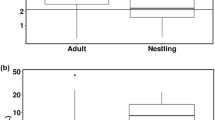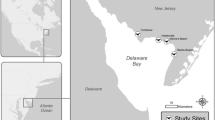Abstract
Mining and smelting at Kellogg-Smelterville, Idaho, resulted in high concentrations of lead in Coeur d'Alene (CDA) River sediments and the floodplain downstream, where American Kestrels (Falco sparverius), Northern Harriers (Circus cyaneus), Red-tailed Hawks (Buteo jamaicensis), Great Horned Owls (Bubo virginianus), and Western Screech-owls (Otus kennicotti) nested. Nestling American Kestrels contained significantly higher (P=0.0012) blood lead concentrations along the CDA River (0.24 µg/g, wet wt) than the nearby reference area (0.087 µg/g). A 35% inhibition of blood δ-aminolevulinic acid dehydratase (ALAD) in nestling Northern Harriers (P=0.0001), 55% in nestling American Kestrels (P=0.0001) and 81% in adult American Kestrels (P=0.0004) provided additional evidence of lead exposure in the CDA River population. In nestling American Kestrels and Northern Harriers, ALAD activity was negatively correlated with lead in blood. An earlier report on Ospreys (Pandion haliaetus) showed slightly less inhibition of ALAD than in American Kestrels, but no significant reduction in hemoglobin or hematocrit and no negative influence on production rates. The adult and nestling American Kestrels along the CDA River contained about twice as much blood lead as Ospreys during the same years (adult 0.46 vs. 0.20 µg/g, and nestling 0.24 vs. 0.09 µg/g), but adults showed a 7.5% reduction in hemoglobin (P=0.0356) and nestlings an 8.2% reduction in hemoglobin (P=0.0353) and a 5.8% reduction in hematocrit (P=0.0482). We did not observe raptor deaths related to lead, and although the production rate for American Kestrels was slightly lower along the CDA River, we found no significant negative relation between productivity and lead. Limited data on the other raptors provide evidence of exposure to lead along the CDA River. Several traits of raptors apparently reduce their potential for accumulating critical levels of lead which is primarily stored in bones of prey species.
Similar content being viewed by others
References
Beyer, W.N., Spann, J.W., Sileo, L., and Franson, F.C.: 1988, ‘Lead Poisoning in Six Captive Avian Species’, Arch. Environ. Contam. Toxicol. 17, 121–130.
Blus, L.J., Henny, C.J., and Mulhern, B.M.: 1987, ‘Concentrations of Metals in Mink and Other Mammals from Washington and Idaho’, Environ. Pollution 44, 307–318.
Blus, L.J., Henny, C.J., Hoffman, D.J., and Grove, R.A.: 1991, ‘Lead Toxicosis in Tundra Swans Near a Mining and Smelting Complex in Northern Idaho’, Arch. Environ. Contam. Toxicol. 21, 549–555.
Blus, L.J., Henny, C.J., Hoffman, D.J., and Grove, R.A.: 1993, ‘Accumulation and Effects of Lead and Cadmium on Wood Ducks Near a Mining and Smelting Complex in Idaho’, Ecotoxicology 2, 139–154.
Burch, H.G. and Siegel, A.L.: 1971, ‘Improved Method for Measurement of Delta-aminolevulinic Acid Dehydratase Activity of Human Erythrocytes’, Clin. Chem. 17, 1038–1041.
Burrows, G.E., Sharp, J.W., and Root, R.G.: 1981, ‘A Survey of Blood Lead Concentrations in Horses in the North Idaho Lead/Silver Belt Area’, Vet. Human Toxicol. 23, 328–330.
Chisholm, J.J. and Brown, D.H.: 1975, ‘Micro-scale Photofluometric Determination of “Free Erythrocyte Porphyrin” (ProtoporphyrinIX)’, Clin. Chem. 21, 1669–1682.
Chmiel, K.M. and Harrison, R.M.: 1981, ‘Lead Content of Small Mammals at a Roadside Site in Relation to the Pathways of Exposure’, Sci. Total Environ. 17, 145–154.
Cummings, J.H., Duke, G.E. and Jegers, A.A.: 1976, ‘Corrosion of Bone by Solutions Simulating Raptor Gastric Juice’, Raptor Research 10, 55–57.
Cytel: 1989, ‘Statxact Statistical Software for Exact Nonparametric Inference’, Cytel Software Corporation, Cambridge, MA, 219 pp.
Dieter, M.P. and Finley, M.T.: 1979, ‘δ-Aminolevulinic Acid Dehydratase Enzyme Activity in Blood, Brain, and Liver of Lead-dosed Ducks’, Environ. Res. 19, 127–135.
Duke, G.E., Jegers, A.A., Loff, G., and Evanson, O.A.: 1975, ‘Gastric Digestion in Some Raptors’, Comp. Biochem. Physiol. 50A, 649–656.
Franson, J.C., Haramis, G.M., Perry, M.C., and Moore, J.F.: 1986, ‘Blood Protoporphyrin for Detecting Lead Exposure in Canvasbacks’, in: Feierabend, J.S. and Russel, A.B. (eds.), ‘Lead Poisoning in Wild Waterfowl — A Workshop’, National Wildlife Federation, Washington, D.C., pp. 32–37.
Henny, C.J.: 1977, ‘Birds of Prey, DDT, and Tussock Moths in Pacific Northwest’, Trans. N. Am. Wildl. Nat. Resources Conf. 42, 397–411.
Henny, C.J., Blus, L.J., Hoffman, D.J., Grove, R.A., and Hatfield, J.S.: 1991, ‘Lead Accumulation and Osprey Production Near a Mining Site on the Coeur d'Alene River, Idaho’, Arch. Environ. Contam. Toxicol. 21, 415–424.
Henny, C.J., Blus, L.J., and Stafford, C.J.: 1983, ‘Effects of Heptachlor on American Kestrels in the Columbia Basin, Oregon’, J. Wildl. Manage. 47, 1080–1087.
Hernberg, S., Nikkanen, J., Mellin, G., and Lilius, H.: 1970, ‘Delta-aminolevulinic Acid Dehydratase as a Measure of Lead Exposure’, Arch. Environ. Health 21, 140–145.
Hinderberger, E.J., Kaiser, M.L., and Koirtyohann, S.R.: 1981, ‘Furnace Atomic Absorption Analysis of Biological Samples Using L'vov Platform and Matrix Modification’, Atomic Spectroscopy 2, 1.
Hoffman, D.J., Franson, J.C., Pattee, O.H., Bunck, C.M., and Anderson, A.: 1985a, ‘Survival, Growth, and Accumulation of Ingested Lead in Nestling American Kestrels (Falco sparverius)’, Arch. Environ. Contam. Toxicol. 14, 89–94.
Hoffman, D.J., Franson, J.C., Pattee, O.H., Bunck, C.M., and Murray, H.C.: 1985b, ‘Biochemical and Hematological Effect of Lead Ingestion in Nestling American Kestrels’, Comp. Biochem. Physiol. 80C, 431–439.
Hornig, C.E., Terpening, D.A., and Bogue, M.W.: 1988, ‘Coeur d'Alene Basin EPA Water Quality Monitoring, 1972–1986’, U.S. Environmental Protection Agency, Seattle, WA, EPA-910/9-88-216, 14 pp + Appendix.
Jenkins, D.W.: 1980, ‘Biological Monitoring of Trace Metals. Vol. 2. Toxic Trace Metals in Plants and Animals of the World’, Part II. U.S. Environmental Protection Agency, Rept. 600/3-80-091:619–778.
Keely, J.F., Hutchison, F.I., Sholley, M.G., and Wai, C.M.: 1976, ‘Heavy Metal Pollution in the Coeur d'Alene Mining District’, Project Technical Report to National Science Foundation Grant No EPP75-08500, Department of Chemistry, University of Idaho, Moscow, ID, 358 pp.
Krynitsky, A.J.: 1987, ‘Preparation of Biological Tissue for Determination of Arsenic and Selenium by Graphite Furnace Atomic Absorption Spectrometry’, Anal. Chem. 59, 1884–1886.
Lehmann, E.L.: 1975, ‘Nonparametrics’, Holden-Day, Inc., San Francisco, CA, 457 pp.
Leonzio, C. and Massi, A.: 1989, ‘Metal Biomonitoring in Birds Eggs: A Critical Experiment’, Bull. Environ. Contam. Toxicol. 43, 402–406.
Mautino, M. and Bell, J.U.: 1987, ‘Hematological Evaluation of Lead Intoxication in Mallards’, Bull. Environ. Contam. Toxicol. 38, 78–85.
Mierau, G.W. and Favara, B.E.: 1975, ‘Lead Poisoning in Roadside Populations of Deer Mice’, Environ. Pollut. 8, 55–64.
Mouw, D.K., Kalitis, M., Anver, M., Schwartz, J., Conston, A., Hartung, R., Cohen, B., and Ringler, D.: 1975, ‘Lead: Possible Toxicity in Urban vs Rural Rats’, Arch. Environ. Health 30, 276–280.
Ohi, G., Seki, H., Akiiyama, K., and Yagyu, H.: 1974, ‘The Pigeon, a Sensor of Lead Pollution’, Bull. Environ. Contam. Toxicol. 12, 92–98.
Pain, D.J., Amiard-Triquet, C., Bavoux, C., Burneleau, G., Eon, L., and Nicolau-Guillaumet, P.: 1993, ‘Lead Poisoning in Wild Populations of Marsh Harriers Circus aeruginosus in the Camargue and Charente-Maritime, France’, Ibis 135, 379–386.
Pattee, O.H.: 1984, ‘Eggshell Thickness and Reproduction in American Kestrels Exposed to Chronic Dietary Lead’, Arch. Environ. Contam. Toxicol. 13, 29–34.
Posner, H.S., Damstra, T., and Nriagu, J.O.: 1978, ‘Human Health Effects of Lead’, in: Nriagu, J.O. (ed.), The Biogeochemistry of Lead in the Environment Part B, Biological Effects, Elsevier/North Holland, Amsterdam, pp. 173–221.
Rabe, F.W. and Bauer, S.D.: 1977, ‘Heavy Metals in Lakes of the Coeur d'Alene River Valley, Idaho’, Northwest Science 52, 183–197.
Rabe, F.W. and Flaherty, D.C.: 1974, ‘The River of Green and Gold’, Idaho Research Foundation, Inc., Natural Resources Series No. 4 Moscow, ID, 98 pp.
Reece, D.E., Felkey, J.R., and Wai, C.M.: 1978, ‘Heavy Metal Pollution in Sediments of the Coeur d'Alene River, Idaho’, Environ. Geol. 2, 289–293.
Roscoe, D.E., Nielson, S.W., Lamola, A.A., and Zuckerman, D.: 1979, ‘A Simple Quantitative Test for Erythrocyte Protoporphyrin in Lead-Poisoned Ducks’, J. Wildl. Dis. 15, 127–136.
SAS Institute: 1985, ‘SAS User's Guide: Statistics’, Version 5 Edition. SAS Inst. Inc., Cary, NC, 956 pp.
Sherrod, S.K.: 1978, ‘Diets of North American Falconiformes’, Raptor Research 12, 49–121.
Wiemeyer, S.N., Bunck, C.M., and Krynitsky, A.J.: 1988, ‘Organochlorine Pesticides, Polychlorinated Biphenyls and Mercury in Osprey Eggs-1970-79-and Their Relationships to Shell Thinning and Productivity’, Arch. Environ. Contam. Toxicol. 17, 767–787.
Author information
Authors and Affiliations
Additional information
The U.S. Government right to retain a non-exclusive, royalty free licence in and to any copyright is acknowledged.
Rights and permissions
About this article
Cite this article
Henny, C.J., Blus, L.J., Hoffman, D.J. et al. Lead in hawks, falcons and owls downstream from a mining site on the Coeur d'Alene River, Idaho. Environ Monit Assess 29, 267–288 (1994). https://doi.org/10.1007/BF00547991
Received:
Revised:
Issue Date:
DOI: https://doi.org/10.1007/BF00547991




